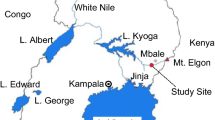Abstract
Delivery management water requirement (DMWR) is the use of bypass water in paddy field irrigation to help maintain desired water levels in irrigation canals and to distribute water to paddy plots in a uniform manner. Diverted irrigation water (DIW), DMWR, and the DMWR/DIW ratio were investigated for concrete lined irrigation ditches with large-sized paddy plots (100 m×100 m) during irrigation periods (May to mid-September). DIW and DMWR were measured at 5- to 10-day intervals at the inlets and outlets of irrigation ditches on stable water supply days. The mean DMWR/DIW ratios in irrigation ditches L1 and L2 over 3 years were 36 and 34%, respectively. The mean DMWR/DIW ratios displayed month-to-month and year-to-year variation. The monthly mean DMWR/DIW ratios were highest (55 and 71%) in June and lowest (<20%) in August and September. The annual mean DMWR/DIW ratios during a dry year markedly decreased to 11%, compared with 42% in other years. The decrease was due to the small DIW and farmers’ water management to maximize capture of limited irrigation water during the drought. The DMWRs in May and June were significantly (p<0.01) correlated with the DIWs, indicating that high DMWR in May and June are attributed to excessive DIW.





Similar content being viewed by others
References
Bos MG, Nugeteren J (1982) On irrigation efficiencies, 3rd edn. International Institute for Land Reclamation and Improvement, Wageningen, Netherlands, 131 pp
JIID—Japanese Institute of Irrigation and Drainage (1990) Final Report of the Committee on the Design Criteria for Irrigation, Drainage, and Farmland Consolidation Projects (in Japanese), Tokyo
JSIDRE—Japanese Society of Irrigation, Drainage, and Reclamation Engineering (1998) Advanced Paddy Field Engineering. Shinzan-sha Sci. & Technology, Tokyo, p 48
JSIDRE—Japanese Society of Irrigation, Drainage, and Reclamation Engineering (2000) Handbook of irrigation, drainage, and reclamation engineering (in Japanese), Main volume, 6th edn. Tokyo, p 183
Ministry of Agriculture and Forestry (2003) Yearbook of agricultural land and water development statistics (in Korean). Anyang, Korea, p 26
SAS Institute (1994) SAS/STAT user’s guide, Version 6, 4th edn. SAS Institute, Cary, NC
Utah State University Foundation (1969) Characteristics and pollution problem of irrigation return flow. Report to Federal Water Pollution Control Admin. Ada, OK
Yukawa K (1972a) Operation loss through system (in Japanese). Trans JSIDRE 41:19–27
Yukawa K (1972b) Operation loss on paddy field irrigation (in Japanese). Trans JSIDRE 41:28–36
Acknowledgement
This work was supported by the Sustainable Water Resources Research program through Grant no.3-4-2
Author information
Authors and Affiliations
Corresponding author
Rights and permissions
About this article
Cite this article
Kim, JS., Oh, SY., Oh, KY. et al. Delivery management water requirement for irrigation ditches associated with large-sized paddy plots in Korea. Paddy Water Environ 3, 57–62 (2005). https://doi.org/10.1007/s10333-005-0072-9
Received:
Accepted:
Published:
Issue Date:
DOI: https://doi.org/10.1007/s10333-005-0072-9




